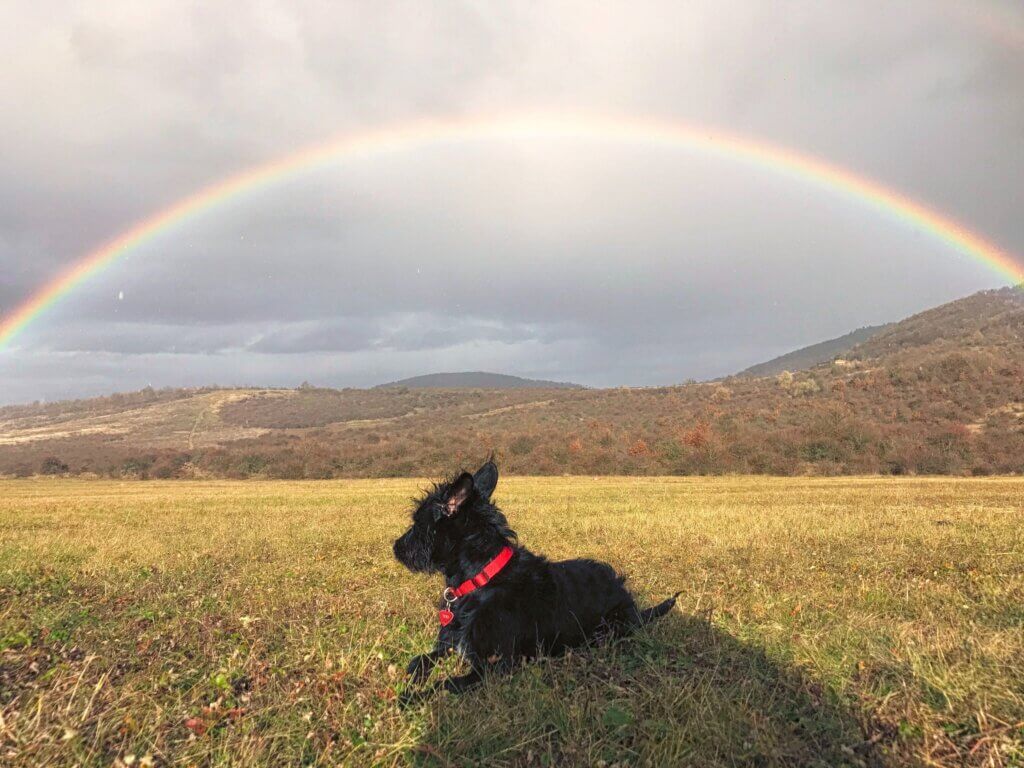Why Dog Poop Color Matters

As a professional pooper scooper service, we feel it is our duty to talk about your dog’s doody – specifically the dog poop color rainbow. It may seem gross, but your dog’s poop can tell you a lot about your four-legged friend’s health. Sometimes, it even gives you a clear indication that something serious is happening and you need to head to the vet.
As Purina explains, “Your dog’s poop can be a great indicator of your dog’s overall health and even prevent some health issues down the road if you know what to look for.” By understanding dog poop color, you will know if your dog is eating well, getting sick, or in need of a food switch.
Healthy Dog Poop
Let’s begin by talking about healthy dog poop. Generally, dog poop should be brown like chocolate. However, if your dog is eating something with added colors, you may see some of those colors when your dog poops. Also, it is important to understand that the brown color can be different from one breed to the next.
Dog owners should pay attention to their dog’s healthy poops, so they know when it changes. When the poop color, consistency, or frequency changes, that means there may be something going on with your four-legged family member.
Black Dog Poop
If your dog has black dog poop, especially if it is tar-like and sticky, it may mean your dog has a stomach ulcer or bleeding in the upper gastrointestinal tract. Preventative Vet explains, “Upper gastro-intestinal bleeding could be the result of stomach or intestinal irritation, a tumor or ulcer, or even a body-wide bleeding problem (such as from liver dysfunction, rodenticide ingestion, or another cause).”
Another reason for black dog poop – activated charcoal. If your dog was given activated charcoal, expect to see black poop.
White Dog Poop
If you notice grey or white fresh dog poop, your pup may have a pancreas or biliary issue. There could be a problem with your dog’s liver or gallbladder. Or, if your dog has been given barium for a radiographic (x-ray) contrast, you may notice white or greyish poop. However, if you see what appears to be white specks that look like rice in your dog’s poop, your dog likely has worms.
Yellow Dog Poop
If you see mustard yellow dog poop, especially poop that has mucus, then it most likely means your dog has a food intolerance. For example, if you recently swapped dog foods, your pup may have an upset stomach. For this reason, it is important to feed your dog a consistent diet and not change pet food frequently.
Green Dog Poop
Green dog poop is fairly common for dogs who eat too much grass or are given certain dental treats like Greenies. But if this is a sudden color change, you may have a bigger issue. As Canine Journal explains, “[Green dog poop] can also be a parasite, rat bait poisoning or other internal issues.”
Orange Dog Poop
If your dog suddenly has orange dog poop, then it may be indicative of pancreatitis (or the inflammation of the pancreas). It can also mean the poop moved through the GI tract too quickly and didn’t have time for bile to breakdown your dog’s food. It is bile that gives the poop a healthy brown color. Without bile, it may appear orange in appearance.
Another reason for orange dog poop – eating carrots!

Beyond the Dog Poop Color Chart
Before you start following your four-legged pal around with a dog poop color chart, it’s important to understand that the key is changes overall. For example, the shape of your dog’s poop also gives you some big clues. If it is very hard and more ball or pellet-like, this indicates dehydration or constipation. In contrast, loose stools indicate an upset stomach.
Basically, consistency is also important. If they are suddenly pooping more than usual or less than usual, there could be a problem. Likewise, if the shape, texture, and color change, it should raise an alarm. You know your dog better than anyone, which means you are probably more familiar with your dog’s poop than anyone else (though Super Scoopers probably comes as a close second).
What Type of Dog Poop Color Warrants a Trip to the Vet
Ultimately, you want to take your dog to the vet if you notice any sudden changes to his or her poop. With that in mind, the following colors warrant a visit to the vet: black dog poop, orange dog poop, or white dog poop. Plus, if you see white specks in your dog’s poop, you need to head to the vet to start a treatment for worms.
Don’t forget to take a sample of your dog’s poop to the vet with you. This may seem strange to you, but it allows your vet to diagnosis your dog. Pet MD says, “Walk into the back area of any clinic and you will see a neatly arrayed line of stool samples waiting to be evaluated; it’s as much a part of a dog’s standard exam as having your blood pressure taken at your own doctor.”
Got Poop Problems? We Can Help!
At Super Scoopers, we answer the call of DOOdy! Beyond helping our clients understand why dog poop colors matter, we also offer residential dog poop scooping in Frisco, TX, and surrounding areas. We take the burden of cleaning dog poop away and allow pet owners to get back to enjoying their yards and four-legged family members.
Just remember – If your dog is suddenly filling your backyard with more poop than normal, especially different colored dog poop, then you need to call both your local veterinarian and Super Scoopers!


